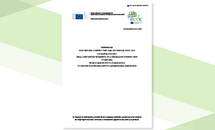Country visit to Estonia to discuss policies relating to antimicrobial resistance
The European Centre for Disease Prevention and Control (ECDC) and the European Commission's Directorate General for Health and Food Safety jointly carried out this country visit to Estonia from 25 to 29 March 2019. The visit was carried out following the invitation from the competent authorities to assist them in the preparation of their national strategy for tackling antimicrobial resistance (AMR) based on a 'One Health' perspective.
Executive summary
According to various European surveillance networks, the antimicrobial consumption in the human health sector in Estonia is low, and the total sales of antimicrobials in the veterinary sector are moderate. However, the veterinary competent authorities are concerned about the increasing use of critically important antimicrobials (CIAs) and the high levels of AMR. Although there is a low level of AMR in key bacteria obtained from human clinical isolates, there are hints that the current AMR situation in the human health sector might be evolving, with hospital outbreaks of resistant bacteria, growing numbers of patients with extended-spectrum beta-lactamase-producing Enterobacteriaceae and an increasing number of isolation-days in some hospitals.
Overall, the report concluded that One Health approach to tackle AMR issues in Estonia is not yet established. Informal collaboration on AMR between the relevant competent authorities and stakeholders has started, but the establishment of the Inter-sectoral steering committee is still pending. Whereas the veterinary AMR action plan for 2019-2023 is in place, the corresponding human health and environmental plans are due this year, as well as the finalisation of the overarching national One Health AMR action plan.
The competent authorities have recognised the need to raise the awareness of AMR among healthcare providers in the human health and veterinary sectors, relevant stakeholders and the general public. Concrete examples in this regard are included in the veterinary AMR action plan and it is expected that awareness-raising will feature prominently in the action plans which are still pending.
In the human health sector, the relatively limited size of the problem of AMR has led to underestimating the potential consequences that AMR could have in the future, and possibly to deprioritising the necessary measures to safeguard the healthcare system from AMR threats. Current surveillance and control includes a lot of manual work, individual effort and personal connections, and these may not be sufficient to face potential future challenges. While hospitals seemed to cope well with the small numbers of patients with multidrug-resistant organisms at the time of the visit, the situation might change if the prevalence of AMR increases. The human resources allocated to the national coordination and oversight of AMR related work raise questions about their sustainability, as the resources did not seem to be proportionate to the scope of activities and the workload. There was also a lack of national funding for implementing improvements in diagnostic capacity and surveillance, including the absence of a functioning public AMR reference laboratory for human health.
In the veterinary sector, the competent authorities are introducing a new risk-based approach to target veterinarians purchasing the largest quantities of CIAs, an approach which may result in a better knowledge of the situation on the ground. However, in the absence of any legal basis on the prudent use of antimicrobials in animals, it might be difficult to achieve significant change in this respect. In particular, the veterinary action plan sets targets to reduce the use of CIAs, but these are expressed as a 30 % reduction in sales by 2023, which could be achieved if the animal population decreases without any real change in prescribing patterns.
In relation to the environmental sector, although the monitoring of the substances under the Water Framework Directive was not carried out in previous years, it is planned to resume in 2019. Other monitoring programmes for residues of pharmacological substances in water are ongoing.
The report outlines various considerations which could be helpful in reviewing and implementing a national, One Health, AMR strategy.







